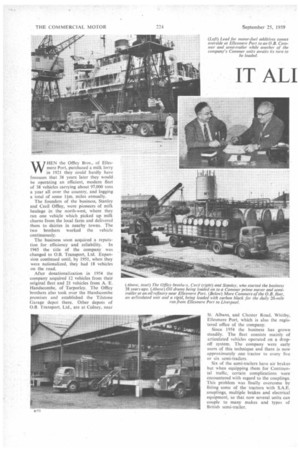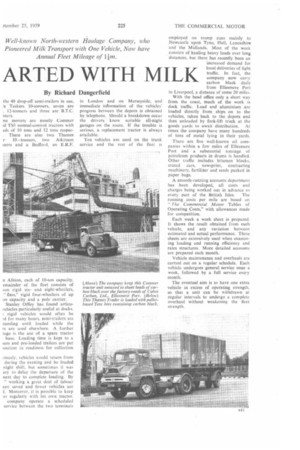IT ALT ARTED WITH MILK
Page 74

Page 75

If you've noticed an error in this article please click here to report it so we can fix it.
By Richard Dangerfield
WHEN the Offley Bros., of Ellesmere Port, purchased a milk lorry in 1921 they could hardly have foreseen that 38 years later they would he operating an efficient, modern fleet of 38 vehicles carrying about 97,000 tons a year all over the country, and logging a total of some lim. miles annually.
The founders of the business, Stanley and Cecil Offley, were pioneers of milk haulage in the north-west, where they ran one vehicle which picked up milk churns from the local farm and delivered them to dairies in nearby towns. The two brothers worked the vehicle continuously.
The business soon acquired a reputa tion for efficiency and reliability. In 1945 the title of the company was changed to 0.B. Transport, Ltd. Expansion continued until, by 1951, when they were nationalized, they had 18 vehicles on the road.
After denationalization in 1954 the company acquired 12 vehicles from their original fleet and 21 vehicles from A. E. Handscornbe, of Tarporley. The Offley brothers also took over the Handscombe premises and established the Tilstone Garage depot there. Other depots of O.B. Transport, Ltd., are at Colney, near St. Albans, and Chester Road, Whitby, Ellesmere Port, which is also the registered office of the company.
Since 1954 the business has grown steadily. The fleet consists mainly of articulated vehicles operated on a dropoff system. The company were early users of this technique and there is now approximately one tractor to every five or six semi-trailers.
Six of the semi-trailers have air brakes but when equipping them for Continental traffic, certain complications were encountered with regard to the couplings. This problem was finally overcome by fitting some of the tractors with S.A.E. couplings, multiple brakes and electrical equipment, so that now several units can couple to many makes and types of British semi-trailer.
the 40 drop-off semi-trailers in use, 'e Tiskers 10-tonners, seven are . 12-tonners and three are B.T.C. mers.
ne movers are mostly Commer id TS 3 normal-control tractors with ads of 10 tons and 12 tons tespec. There are also two Thames r 10 tonners, two Atkinson tners and a Bedford, an E.K.F.
n Albion, each of 10-ton capacity. emainder of the fleet consists of son rigid sixand eight-wheelers, " flats," rigid four-wheelers of up in capacity and a pole carrier. Stanley Offiey has found articuiehicles particularly useful at docks. rigid vehicles would often be !d for many hours, semi-trailers are tareling until loaded while the rs arc used elsewhere. A further tage is the use of a spare tractor base. Loading time is kept to a iurn and pre-loaded trailers are put iosition in readiness for collection
jously, vehicles would return from during the evening and be loaded night shift, but sometimes it was ary to delay the departure of the next day to complete loading. By " working a great deal of labour een saved and fewer vehicles are J. Moreover, it is possible to keep .er regularly with his own tractor.
company operate a scheduled service between the two terminals in London and on Merseyside, and immediate information of the vehicles' progress between the depots is obtained by telephone. Should a breakdown occur the drivers know suitable all-night garages on the route. If the trouble is serious, a replacement tractor is always available.
Ten vehicles are used on the trunk service and the rest of the fleet is
employed on tramp . runs mainly to Newcastle upon Tyne, Hull, Lancashire and the Midlands. Most of the work consists of hauling heavy loads over long distances, but there has recently been an increased demand for local deliveries of light traffic. In fact, the company now carry carbon black daily from Ellesmere Port to Liverpool, a distance of some 20 miles.
With the head office only a short way from the coast, much of the work is dock traffic. _Lead and •aluminium are loaded directly from ships on to the vehicles, taken back to the depots and then unloaded by fork-lift truck at the goods yards to await distribution. At times the company have many hundreds of tons of metal lying in their yards.
There are five well-known oil companies within a few miles of Ellesmere Port and a substantial tonnage of petroleum products in drums is handled. Other traffic includes bitumen Mocks, crated cars, newsprint, contracting machinery, fertilizer and seeds packed in paper bags.
A smooth-running accounts department has been developed, all costs and charges being worked out in advance to
every part of the British Isles. The running costs per mile are based on "The Commercial Motor Tables of Operating Costs," with allowances made for competition.
Each week a work sheet is prepared. It shows the result obtained from each vehicle, and any variation between estimated and actual performance. These sheets arc extensively used when examining loading and running efficiency and rates structures. More detailed accounts are prepared each month.
Vehicle maintenance and overhauls are carried ,out on a regular schedule. Each vehicle undergoes general service once a week, followed by a full service every month.
The eventual aim is to have one extra vehicle in excess of operating strength, so that a unit can be withdrawn at regular intervals to undergo a complete overhaul without weakening the fleet strength.




















































































































